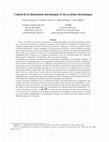Papers by Vincent Vigneron
2014 IEEE 26th International Conference on Tools with Artificial Intelligence, 2014
In this article, we give some insights of a novel method for active environment recognition in mo... more In this article, we give some insights of a novel method for active environment recognition in mobile robotics. The basic idea consists on utilizing a Physics-like interac- tion law to x a relation between sensors and effectors val- ues at any time. Our main assumption is that the trajectory of the robot in the phase space, which depends uniquely on
Intelligent Autonomous Systems, 2006
Through a Dynamical Systems approach to robotics, we introduce a mea- sure of distinguishability ... more Through a Dynamical Systems approach to robotics, we introduce a mea- sure of distinguishability between different behaviours of a robot, in an uncertain context, thanks to interval analysis.
2007 IEEE Conference on Advanced Video and Signal Based Surveillance, 2007
Face localization using neural network is presented in this communication. Neural network was tra... more Face localization using neural network is presented in this communication. Neural network was trained with two different kinds of feature parameters vectors; Zernike moments and Eigenfaces. In each case, coordinate vectors of pixels surrounding faces in the images were used as target vectors on the supervised training procedure. Thus, trained neural network provides on its output layer a coordinates vector (R,θ) representing pixels surrounding the face contained in treated image. This way to proceed gives accurate faces contours which are well adapted to the faces shapes. Performances obtained for the two kinds of training feature parameters were recorded using a quantitative measurement criterion according to experiences carried out on the XM2VTS database.

16th International IEEE Conference on Intelligent Transportation Systems (ITSC 2013), 2013
ABSTRACT This paper presents a new radar sensor modeling for Advanced Driver Assistance Systems (... more ABSTRACT This paper presents a new radar sensor modeling for Advanced Driver Assistance Systems (ADAS) prototyping. This virtual model is embedded in the SiVIC platform dedicated to the simulation of vehicles, infrastructure and sensors. Lots of simulators already exist addressing radar simulation, but none of them is designed to address in the same time the following objectives: real-time computation, highly sampled signal generation, multiple radar technologies, and, hardware and software platform integration for ADAS prototyping. In this paper, we proposed such a solution solving this issue and a focus will be done on the radar sensor modeling, from material modeling to implemented technology and associated signal processing. First results of this radar sensor modeling is carried out in motorway scenario.

Dans cette article, on cherche à caractériser un système dynamique de manière quantitative à part... more Dans cette article, on cherche à caractériser un système dynamique de manière quantitative à partir de sa dimension intrinsèque. La dimension intrinsèque de l'espace d'état représente le nombre de coordonnées indépendantes décrivant la position d'un point sur l'attracteur, c'est donc le nombre de dégré de liberté minimum du système dynamique. Cette dimension est difficile à obtenir. Plusieurs méthodes ont été proposées pour la mesurer, notamment la dimension de corrélation et la dimension de Hausdorff-Besicovitch, qui se confond, à la limite, avec la capacité introduite par Kolmogoroff. Ces dimensions sont indépendantes de la fréquence avec laquelle une trajectoire visite les différentes parties de l'attracteur. Elles mesurent "simplement" l'intermittence dans ce système dynamique. Le problème de l'estimation des dimensions pour des données empiriques est un problème complexe. Si d'un point de vue statistique celui-ci n'est apparu que récemment dans l'étude des systèmes dynamiques 1 , il fut au départ abordé d'un point de vue "physique". En particulier avec les travaux de Ceys et Pyragas 2 qui ont mis au point une procédure permettant de déterminer le nombre de degrés de liberté minimum caractérisant un système dynamique chaotique. Il s'agit alors de trouver des segments de la série coïncidant dans un nombre de points finis Ñ. La procédure est bien sûre locale et dépend fortement du segment initial. Afin de la rendre robuste, on peut calculer les déviations moyennes entre le segment initial et les autres segments, et déterminer ainsi le nombre Ñ pour lesquels elles sont minimales. Les idées de base développées dans cette procédure ne sont pas éloignées de celles développées par Grassberger et Proccacia (1983) quand ils ont établi la procédure de calcul de la dimension de corrélation. A travers une série d'expériences sur la courbe de Von Koch, nous démontrons que ces dimensions sont sensibles au bruit et à la nature du bruit, au nombre d'observations (qui doit être considérable), à la dimension de l'espace d'observation, etc., donc peu utilisables en l'état pour des applications d'ingénieurie. Par contre, en observant que les graphes de ces dimensions ont l'allure de fonctions de répartition ´Üµ, l'étude de la densité associée ´Üµ ´Üµ Ü est beaucoup plus fructueuse. Si dans le cas précédent, on ne s'intéresse pas à la fréquence avec laquelle une trajectoire d'un attracteur visite les cubes, on rajoute ici une information supplémentaire en considérant la fréquence avec laquelle une orbite typique visite les différentes régions de l'attracteur. 1 SMITH L. A. -Intrinsic Limits on Dimension Calculations -Phys. Lett. A ,Volume 133, 1988, pages 283-288. 2 CEYS A. et PYRAGAS K. -Estimation of the number of degrees of freedom from chaotic time series -Phys Lett, 128, 1988, pages 227-230.
Pattern Recognition Letters, 2010
RÉSUMÉ. Le travail proposé ici s' inscrit dans le contexte de la biométrie dont l'objec... more RÉSUMÉ. Le travail proposé ici s' inscrit dans le contexte de la biométrie dont l'objectif est de l'identification d'une personne à travers des informations biologiques ou comportementales. Nous proposons des travaux liés à deux étapes du processus de ...
Independent Component Analysis, 2010
... 426 Sina Hamidi Ghalehjegh, Massoud Babaie-Zadeh, and Christian Jutten Second-Order Source Se... more ... 426 Sina Hamidi Ghalehjegh, Massoud Babaie-Zadeh, and Christian Jutten Second-Order Source Separation Based on Prior Knowledge Realized in a Graph Model..... 434 Florian Blochl, Andreas Kowarsch, and Fabian J. Theis Noise Adjusted PCA ...
Lecture Notes in Computer Science, 2003

Lecture Notes in Computer Science, 2010
We study a sparse coding learning algorithm that allows for a simultaneous learning of the data s... more We study a sparse coding learning algorithm that allows for a simultaneous learning of the data sparseness and the basis functions. The algorithm is derived based on a generative model with binary latent variables instead of continuous-valued latents as used in classical sparse coding. We apply a novel approach to perform maximum likelihood parameter estimation that allows for an efficient estimation of all model parameters. The approach is a new form of variational EM that uses truncated sums instead of factored approximations to the intractable posterior distributions. In contrast to almost all previous versions of sparse coding, the resulting learning algorithm allows for an estimation of the optimal degree of sparseness along with an estimation of the optimal basis functions. We can thus monitor the time-course of the data sparseness during the learning of basis functions. In numerical experiments on artificial data we show that the algorithm reliably extracts the true underlying basis functions along with noise level and data sparseness. In applications to natural images we obtain Gabor-like basis functions along with a sparseness estimate. If large numbers of latent variables are used, the obtained basis functions take on properties of simple cell receptive fields that classical sparse coding or ICA-approaches do not reproduce.
2013 International Conference on Connected Vehicles and Expo (ICCVE), 2013
We propose a detection and classification system for various road situations, which is robust to ... more We propose a detection and classification system for various road situations, which is robust to light changes and different road markings. The road curves in an image are described with a Hough Transform, where histograms accumulate the contrast lines for each pixel. The resulting 2D histograms are used to train a Kohonen Neural Network. The final output classification can be used to improve road security, indicating dangerous situations to the driver or feeding a driving control system. 461 77.6%
Accurate and reliable vehicle localization is a key component of numerous automotive and Intellig... more Accurate and reliable vehicle localization is a key component of numerous automotive and Intelligent Transportation System (ITS) applications, including active vehicle safety systems, real time estimation of traffic conditions, and high occupancy tolling. Various safety critical vehicle applications in particular, such as collision avoidance or mitigation, lane change management or emergency braking assistance systems, rely principally on the accurate and reliable knowledge of vehicles? positioning within given vicinity.









Uploads
Papers by Vincent Vigneron